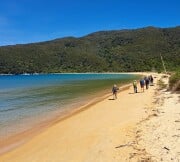A World Apart
Deep within the Te Urewera lands of the central east North Island lies Lake Waikaremoana.. Bright blue lakes floating on oceans of forest. This remote, mist-shrouded lake, whose name means “sea of rippling waters", is the deepest lake in the North Island and far less-frequented than many of its peers. Unlike many of New Zealand’s more accessible outdoor destinations, Waikaremoana demands commitment - the unsealed roads into the North Island’s heartland wind through dense primaeval forest. Once arrived, the silence is profound, broken only by birdsong and the lapping of water on ancient shores.
Created by a massive landslide over 2,200 years ago, the lake stretches across 54 square kilometres, its edges fringed by unbroken rainforest. Te Urewera contains one of the largest remaining tracts of native forest in the North Island, holding some of the country’s oldest and biggest trees. Kahikatea, New Zealand’s tallest species of tree, reaches 60 metres here and is joined by giant hardwoods, Rimu, Tōtara, Mataī, and Miro in forming an illustrious canopy.
Hiking Lake Waikaremoana
The Lake Waikaremoana Great Walk is a multi-day hiking track circumnavigating about half of the Lake. The trail climbs above the dramatic Panekire Bluff, passing waterfalls, and offering you panoramic views. Weave through fern-lined paths and see the many finger-like inlets of the lake. This is one of the most isolated of New Zealand’s Great Walks.
Te Urewera as a Living Landscape
Birdlife is abundant. Kākā (forest parrot), kererū (wood pigeon), and the elusive kōkako thrive here, their calls echoing through the forest. This is a place of deep connection to the land, and for Tuhoe Māori, Te Urewera is sacred, governed by its own legal personhood and recognized as a living entity.
Waikaremoana and Te Urewera have a feeling unto themselves, unlike anywhere else in New Zealand and perhaps the world. There’s just nature here, and you.
 4 Days
4 Days






